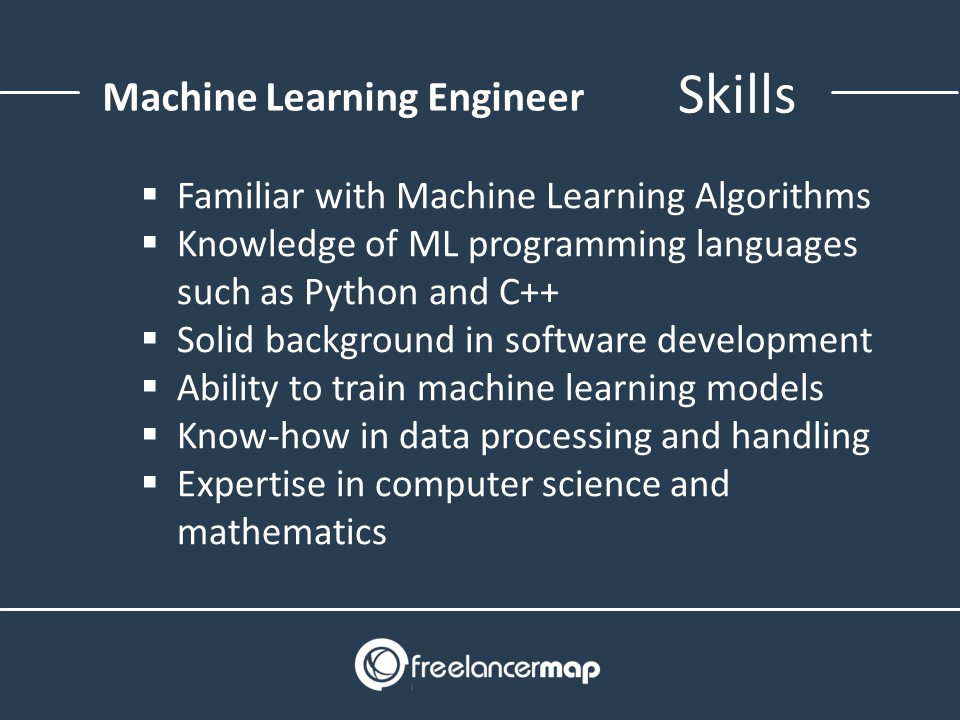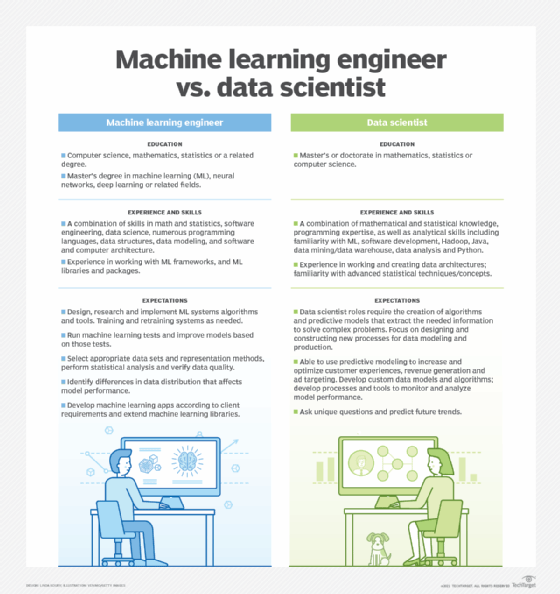All Categories
Featured
Table of Contents
- – How To Become A Machine Learning Engineer [202...
- – The smart Trick of How To Become A Machine Lea...
- – Rumored Buzz on Machine Learning Engineer Course
- – The 5-Minute Rule for Machine Learning Applie...
- – The Best Strategy To Use For How To Become A...
- – What Does Machine Learning In A Nutshell For...
- – A Biased View of Machine Learning Engineer L...
Some people assume that that's cheating. Well, that's my entire job. If somebody else did it, I'm going to use what that person did. The lesson is placing that aside. I'm requiring myself to analyze the possible solutions. It's even more concerning taking in the material and trying to use those concepts and much less about discovering a collection that does the work or finding someone else that coded it.
Dig a little bit deeper in the math at the start, so I can build that foundation. Santiago: Finally, lesson number seven. This is a quote. It claims "You have to recognize every detail of an algorithm if you want to use it." And then I say, "I think this is bullshit advice." I do not believe that you have to understand the nuts and screws of every algorithm before you utilize it.
I would have to go and examine back to actually obtain a far better intuition. That doesn't indicate that I can not solve things using neural networks? It goes back to our sorting example I think that's just bullshit guidance.
As a designer, I've worked with several, lots of systems and I have actually utilized numerous, many points that I do not understand the nuts and bolts of exactly how it functions, even though I comprehend the effect that they have. That's the last lesson on that thread. Alexey: The amusing thing is when I consider all these libraries like Scikit-Learn the formulas they utilize inside to implement, for instance, logistic regression or something else, are not the exact same as the algorithms we research in machine discovering courses.
How To Become A Machine Learning Engineer [2022] for Dummies
Also if we attempted to learn to get all these fundamentals of device understanding, at the end, the formulas that these collections make use of are various. Santiago: Yeah, definitely. I assume we need a whole lot a lot more materialism in the industry.

I typically talk to those that desire to function in the market that want to have their impact there. I do not dare to speak regarding that since I do not recognize.
Right there outside, in the market, materialism goes a lengthy method for certain. Santiago: There you go, yeah. Alexey: It is an excellent inspirational speech.
The smart Trick of How To Become A Machine Learning Engineer (With Skills) That Nobody is Discussing
One of the things I desired to ask you. Initially, let's cover a pair of things. Alexey: Allow's begin with core tools and frameworks that you require to discover to in fact change.
I understand Java. I know how to make use of Git. Possibly I understand Docker.
What are the core tools and structures that I require to discover to do this? (33:10) Santiago: Yeah, definitely. Fantastic concern. I assume, leading, you should begin finding out a little bit of Python. Given that you already understand Java, I do not think it's going to be a big transition for you.
Not since Python is the very same as Java, but in a week, you're gon na get a lot of the differences there. Santiago: Then you get specific core tools that are going to be utilized throughout your whole career.
Rumored Buzz on Machine Learning Engineer Course
That's a collection on Pandas for information control. And Matplotlib and Seaborn and Plotly. Those 3, or among those 3, for charting and showing graphics. After that you obtain SciKit Learn for the collection of artificial intelligence formulas. Those are tools that you're mosting likely to need to be utilizing. I do not recommend just going and learning more about them out of the blue.
We can chat about certain programs later. Take among those courses that are going to begin introducing you to some problems and to some core concepts of artificial intelligence. Santiago: There is a training course in Kaggle which is an introduction. I don't bear in mind the name, but if you most likely to Kaggle, they have tutorials there free of cost.
What's excellent concerning it is that the only need for you is to recognize Python. They're going to present a trouble and tell you exactly how to use choice trees to address that details trouble. I assume that process is incredibly effective, since you go from no device learning history, to recognizing what the issue is and why you can not address it with what you recognize right now, which is straight software design methods.
The 5-Minute Rule for Machine Learning Applied To Code Development
On the other hand, ML engineers focus on building and releasing maker knowing designs. They concentrate on training designs with data to make predictions or automate tasks. While there is overlap, AI engineers handle even more varied AI applications, while ML engineers have a narrower concentrate on artificial intelligence algorithms and their sensible execution.

Artificial intelligence designers concentrate on creating and releasing artificial intelligence designs into production systems. They deal with engineering, ensuring versions are scalable, reliable, and integrated right into applications. On the other hand, information researchers have a more comprehensive function that consists of data collection, cleansing, expedition, and structure designs. They are frequently in charge of removing insights and making data-driven choices.
As organizations significantly take on AI and artificial intelligence technologies, the need for proficient professionals grows. Artificial intelligence designers service innovative tasks, add to advancement, and have competitive incomes. Success in this area requires constant learning and maintaining up with progressing innovations and techniques. Equipment knowing duties are usually well-paid, with the possibility for high gaining capacity.
ML is basically different from conventional software program advancement as it concentrates on training computers to gain from information, instead of programming explicit regulations that are performed methodically. Unpredictability of outcomes: You are probably utilized to writing code with predictable outputs, whether your function runs as soon as or a thousand times. In ML, however, the results are less certain.

Pre-training and fine-tuning: Exactly how these designs are trained on large datasets and then fine-tuned for specific jobs. Applications of LLMs: Such as text generation, view analysis and info search and access.
The Best Strategy To Use For How To Become A Machine Learning Engineer - Uc Riverside
The ability to take care of codebases, combine modifications, and settle conflicts is equally as crucial in ML advancement as it is in traditional software application projects. The abilities developed in debugging and testing software applications are extremely transferable. While the context might change from debugging application reasoning to recognizing issues in data processing or design training the underlying principles of organized examination, theory testing, and repetitive refinement are the very same.
Machine learning, at its core, is heavily dependent on data and chance concept. These are critical for comprehending just how formulas learn from information, make forecasts, and assess their performance.
For those interested in LLMs, a comprehensive understanding of deep discovering architectures is beneficial. This consists of not only the mechanics of semantic networks yet also the architecture of certain models for different use situations, like CNNs (Convolutional Neural Networks) for image processing and RNNs (Persistent Neural Networks) and transformers for consecutive information and all-natural language processing.
You must understand these concerns and find out methods for recognizing, alleviating, and connecting concerning predisposition in ML designs. This consists of the prospective effect of automated choices and the ethical implications. Numerous versions, specifically LLMs, require significant computational resources that are typically offered by cloud platforms like AWS, Google Cloud, and Azure.
Building these skills will certainly not only facilitate an effective change right into ML however likewise ensure that developers can add properly and properly to the improvement of this dynamic area. Theory is essential, yet nothing beats hands-on experience. Start servicing jobs that allow you to use what you've discovered in a practical context.
Develop your projects: Start with easy applications, such as a chatbot or a text summarization device, and gradually raise intricacy. The field of ML and LLMs is quickly advancing, with brand-new breakthroughs and technologies arising consistently.
What Does Machine Learning In A Nutshell For Software Engineers Do?
Contribute to open-source jobs or create blog messages regarding your learning journey and tasks. As you get expertise, begin looking for chances to integrate ML and LLMs into your job, or seek new roles focused on these technologies.

Vectors, matrices, and their function in ML algorithms. Terms like design, dataset, attributes, tags, training, reasoning, and recognition. Data collection, preprocessing methods, design training, analysis processes, and release considerations.
Decision Trees and Random Woodlands: Intuitive and interpretable versions. Assistance Vector Machines: Optimum margin category. Matching issue kinds with suitable designs. Balancing performance and intricacy. Fundamental structure of neural networks: neurons, layers, activation features. Layered calculation and forward breeding. Feedforward Networks, Convolutional Neural Networks (CNNs), Frequent Neural Networks (RNNs). Picture recognition, sequence prediction, and time-series analysis.
Information flow, improvement, and feature engineering approaches. Scalability concepts and efficiency optimization. API-driven strategies and microservices assimilation. Latency management, scalability, and version control. Continual Integration/Continuous Implementation (CI/CD) for ML operations. Model surveillance, versioning, and efficiency monitoring. Identifying and attending to changes in model efficiency gradually. Attending to performance traffic jams and resource monitoring.
A Biased View of Machine Learning Engineer Learning Path

Course OverviewMachine understanding is the future for the next generation of software program experts. This course functions as a guide to machine learning for software application designers. You'll be presented to three of the most appropriate parts of the AI/ML discipline; managed discovering, neural networks, and deep knowing. You'll grasp the distinctions in between traditional shows and device discovering by hands-on advancement in monitored understanding prior to constructing out intricate dispersed applications with semantic networks.
This training course works as an overview to machine lear ... Program More.
Table of Contents
- – How To Become A Machine Learning Engineer [202...
- – The smart Trick of How To Become A Machine Lea...
- – Rumored Buzz on Machine Learning Engineer Course
- – The 5-Minute Rule for Machine Learning Applie...
- – The Best Strategy To Use For How To Become A...
- – What Does Machine Learning In A Nutshell For...
- – A Biased View of Machine Learning Engineer L...
Latest Posts
Back-end Engineering Interview Guide – What To Expect
Netflix Software Engineer Hiring Process – Interview Prep Tips
How To Create A Study Plan For A Software Engineering Technical Interview
More
Latest Posts
Back-end Engineering Interview Guide – What To Expect
Netflix Software Engineer Hiring Process – Interview Prep Tips
How To Create A Study Plan For A Software Engineering Technical Interview